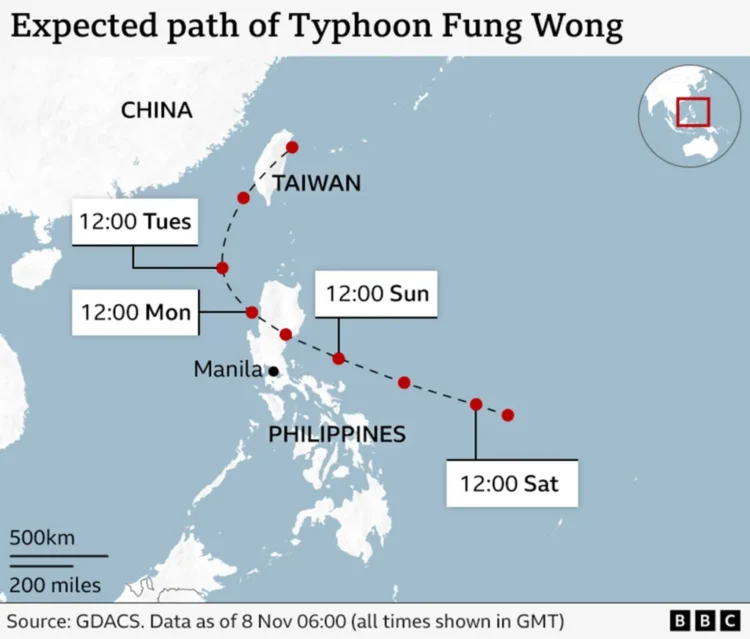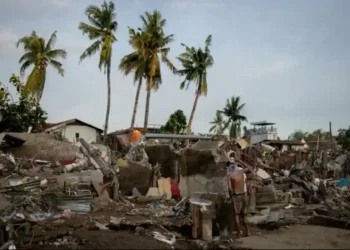Nearly one million people across the Philippines have been evacuated as Super Typhoon Fung-wong—known locally as Uwan—approaches the country’s eastern coast. The powerful storm, expected to make landfall on Sunday evening, has prompted widespread shutdowns and emergency preparations across Luzon, the country’s most populous island.
Storm Strength and Forecast Path
The Philippine Atmospheric, Geophysical and Astronomical Services Administration (PAGASA) upgraded Fung-wong to a super typhoon, reporting sustained winds of around 185 kilometers per hour (115 mph) and gusts reaching up to 230 km/h (143 mph). Forecasters warned that the storm’s northwesterly path toward Luzon could bring a “high risk of life-threatening and damaging storm surge,” with waves potentially exceeding three meters (10 feet).
Fung-wong made its first landfall in the eastern Bicol region early Sunday before moving past the Polillo Islands later in the afternoon. The storm is expected to weaken slightly as it crosses land between the coastal districts of Baler and Casiguran but remain strong enough to cause extensive damage across central and northern Luzon.
Mass Evacuations and Widespread Disruptions
Local governments have evacuated more than 900,000 residents from coastal and low-lying areas, particularly in regions facing direct exposure to the typhoon’s core. Schools have cancelled in-person classes or shifted online, while nearly 300 domestic and international flights have been suspended.
Eastern provinces such as Catanduanes, Aurora, and Quezon were among the first to experience intense winds and heavy rainfall. In Catanduanes, authorities reported “extreme conditions” by Sunday morning and urged all residents to remain in shelters until conditions improve.
In Aurora province, 21-year-old hotel worker Hagunoy told BBC News that police visited repeatedly to ensure all coastal hotels had evacuated their guests. “The tide rose quickly, and the winds became very strong,” he said, adding that he planned to stay just long enough to secure the property before heading home to safety.
Heavy Rainfall and Flooding Concerns
Meteorologists warned that parts of Luzon could receive over 200 millimeters of rain, with 100–200 millimeters expected across Metro Manila. The deluge could trigger severe flooding and landslides, particularly in mountainous areas and communities along riverbanks.
Emergency shelters in central Aurora have already accommodated hundreds of evacuees, many of them families with young children who have no memory of Typhoon Haiyan—a catastrophic storm that killed more than 6,000 people in 2013.
Compounding Crises: Aftermath of Typhoon Kalmaegi
Fung-wong arrives just days after Typhoon Kalmaegi left widespread devastation across the country, killing at least 204 people and leaving over 100 others missing. The earlier storm triggered landslides, flash floods, and the collapse of entire neighborhoods in some provinces.
Kalmaegi’s aftermath has compounded fears among residents, with many still reeling from losses. “We decided to evacuate because the recent typhoon brought floods in our area, and now I just want to keep my family safe,” evacuee Norlito Dugan told AFP from a church shelter in Sorsogon. Another resident, Maxine Dugan, added, “The waves near my house are now huge. It’s too dangerous to stay.”
Five deaths were also reported in Vietnam as Kalmaegi moved westward, bringing destructive winds that uprooted trees and tore off rooftops.
Government Response and Emergency Measures
The Philippine government has declared a nationwide state of calamity in response to Kalmaegi’s destruction and in anticipation of further damage from Fung-wong. The declaration allows faster allocation of emergency funds and mobilization of rescue and relief operations.
Rescue efforts that had been ongoing after Kalmaegi were suspended due to deteriorating weather conditions. Authorities have urged the public to stay indoors, follow local evacuation orders, and monitor official weather bulletins.
Typhoons and the Climate Connection
The Philippines, located in the Pacific’s typhoon belt, faces an average of 20 tropical cyclones each year, about half of which directly affect the archipelago. While scientists say climate change does not necessarily increase the number of typhoons globally, it is likely making them stronger.
According to the World Meteorological Organization (WMO), rising ocean temperatures and a warmer atmosphere can intensify tropical storms, leading to higher wind speeds, heavier rainfall, and more destructive storm surges.
Fung-wong’s rapid strengthening, following closely on the heels of another deadly storm, underscores the growing challenges facing the Philippines as it confronts increasingly volatile weather patterns.
This article was rewritten by JournosNews.com based on verified reporting from trusted sources. The content has been independently reviewed, fact-checked, and edited for accuracy, tone, and global readability in accordance with Google News standards.
Stay informed with JournosNews.com — your trusted source for verified global reporting and in-depth analysis. Follow us on Google News, BlueSky, and X for real-time updates.
JournosNews.com follows Google News content standards with original reporting, verified sources, and global accessibility. Articles are fact-checked and edited for accuracy and neutrality.














